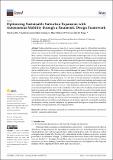Optimizing Sustainable Suburban Expansion with Autonomous Mobility through a Parametric Design Framework
Author(s)
Zhu, Chenhao; Susskind, Jonah; Giampieri, Mario; O’Neil, Hazel Backus; Berger, Alan M.
Downloadland-12-01786-v2.pdf (17.09Mb)
Publisher with Creative Commons License
Publisher with Creative Commons License
Creative Commons Attribution
Terms of use
Metadata
Show full item recordAbstract
Today, suburban areas are home to an ever-increasing majority of the global population. Models indicate that the next generation of US metropolitan growth will rapidly continue outside of urban cores, where car-based development patterns have served as the dominant paradigm for more than a century. With the emergence of autonomous mobility technologies and services, the suburbs of the future offer key opportunities to tackle pressing environmental challenges, such as significant GHG emissions from private vehicle trips, underutilized and fragmented landscape spaces, and a high proportion of impervious surfaces. To leverage this opportunity, our research team employed a novel scenario-based parametric modeling framework to generate and optimize suburban land use patterns and block configurations that leverage autonomous mobility to optimize environmental performance and accessibility metrics. The framework performed through our project, NOGAS (Next Optimized Generation of Autonomous Suburbs), consists of five key parametric modules and a heuristic design process covering various planning and design decision-making stages including scenario generation, analysis, optimization, and visualization. It is the first of its kind tailored for suburban settings with emerging mobility systems, which, more importantly, prioritizes landscape performance and accessibility over the traditional automobile-centric approach in suburban development. One of the most significant findings from this research is that substantial enhancements to a neighborhood’s environmental performance and overall accessibility can be achieved by modifying existing suburban land use patterns and individual block configurations, without the necessity of increasing density. The results of the framework further suggest that a strategic atomized land use scheme, combined with an innovative clustered block typology, is favored for the anticipated widespread adoption of autonomous mobility systems and improved environmental performance. The innovative methods and findings introduced in this research illuminate an alternative approach to sustainable suburban development, offering valuable insights for city planners and developers to shape future suburban master plans, zoning regulations, and design guidelines.
Date issued
2023-09-14Department
Massachusetts Institute of Technology. Department of Urban Studies and PlanningPublisher
Multidisciplinary Digital Publishing Institute
Citation
Land 12 (9): 1786 (2023)
Version: Final published version